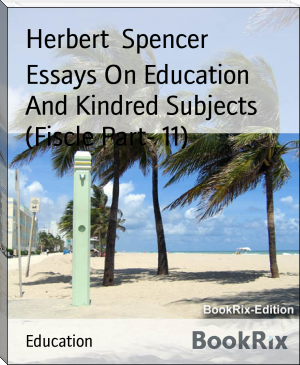Essays On Education And Kindred Subjects (Fiscle Part- 11), Herbert Spencer [historical books to read .txt] 📗

- Author: Herbert Spencer
Book online «Essays On Education And Kindred Subjects (Fiscle Part- 11), Herbert Spencer [historical books to read .txt] 📗». Author Herbert Spencer
"To Place Before The Student A Simple, Yet Logical Mode Of Instruction;"
And To This End Sets Out With A Number Of Definitions Thus:--
"A Simple Line In Drawing Is A Thin Mark Drawn From One Point To
Another.
"Lines May Be Divided, As To Their Nature In Drawing, Into Two
Classes:--
"1. _Straight_, Which Are Marks That Go The Shortest Road Between
Two Points, As A B.
"2. Or _Curved_, Which Are Marks Which Do Not Go The Shortest Road
Between Two Points, As C D."
And So The Introduction Progresses To Horizontal Lines, Perpendicular
Lines, Oblique Lines, Angles Of The Several Kinds, And The Various
Figures Which Lines And Angles Make Up. The Work Is, In Short, A Grammar
Of Form, With Exercises. And Thus The System Of Commencing With A Dry
Analysis Of Elements, Which, In The Teaching Of Language, Has Been
Exploded, Is To Be Re-Instituted In The Teaching Of Drawing. We Are To
Set Out With The Definite, Instead Of With The Indefinite. The Abstract
Is To Be Preliminary To The Concrete. Scientific Conceptions Are To
Precede Empirical Experiences. That This Is An Inversion Of The Normal
Order, We Need Scarcely Repeat. It Has Been Well Said Concerning The
Custom Of Prefacing The Art Of Speaking Any Tongue By A Drilling In The
Parts Of Speech And Their Functions, That It Is About As Reasonable As
Prefacing The Art Of Walking By A Course Of Lessons On The Bones,
Muscles, And Nerves Of The Legs; And Much The Same Thing May Be Said Of
The Proposal To Preface The Art Of Representing Objects, By A
Nomenclature And Definitions Of The Lines Which They Yield On Analysis.
These Technicalities Are Alike Repulsive And Needless. They Render The
Study Distasteful At The Very Outset; And All With The View Of Teaching
That Which, In The Course Of Practice, Will Be Learnt Unconsciously.
Just As The Child Incidentally Gathers The Meanings Of Ordinary Words
From The Conversations Going On Around It, Without The Help Of
Part 1 Chapter 2 (Intellectual Education) Pg 33Dictionaries; So, From The Remarks On Objects, Pictures, And Its Own
Drawings, Will It Presently Acquire, Not Only Without Effort But Even
Pleasurably, Those Same Scientific Terms Which, When Taught At First,
Are A Mystery And A Weariness.
If Any Dependence Is To Be Placed On The General Principles Of Education
That Have Been Laid Down, The Process Of Learning To Draw Should Be
Throughout Continuous With Those Efforts Of Early Childhood, Described
Above As So Worthy Of Encouragement. By The Time That The Voluntary
Practice Thus Initiated Has Given Some Steadiness Of Hand, And Some
Tolerable Ideas Of Proportion, There Will Have Arisen A Vague Notion Of
Body As Presenting Its Three Dimensions In Perspective. And When, After
Sundry Abortive, Chinese-Like Attempts To Render This Appearance On
Paper, There Has Grown Up A Pretty Clear Perception Of The Thing To Be
Done, And A Desire To Do It, A First Lesson In Empirical Perspective May
Be Given By Means Of The Apparatus Occasionally Used In Explaining
Perspective As A Science. This Sounds Alarming; But The Experiment Is
Both Comprehensible And Interesting To Any Boy Or Girl Of Ordinary
Intelligence. A Plate Of Glass So Framed As To Stand Vertically On The
Table, Being Placed Before The Pupil, And A Book Or Like Simple Object
Laid On The Other Side Of It, He Is Requested, While Keeping The Eye In
One Position, To Make Ink-Dots On The Glass So That They May Coincide
With, Or Hide, The Corners Of This Object. He Is Next Told To Join These
Dots By Lines; On Doing Which He Perceives That The Lines He Makes Hide,
Or Coincide With, The Outlines Of The Object. And Then By Putting A
Sheet Of Paper On The Other Side Of The Glass, It Is Made Manifest To
Him That The Lines He Has Thus Drawn Represent The Object As He Saw It.
They Not Only Look Like It, But He Perceives That They Must Be Like It,
Because He Made Them Agree With Its Outlines; And By Removing The Paper
He Can Convince Himself That They Do Agree With Its Outlines. The Fact
Is New And Striking; And Serves Him As An Experimental Demonstration,
That Lines Of Certain Lengths, Placed In Certain Directions On A Plane,
Can Represent Lines Of Other Lengths, And Having Other Directions, In
Space. By Gradually Changing The Position Of The Object, He May Be Led
To Observe How Some Lines Shorten And Disappear, While Others Come Into
Sight And Lengthen. The Convergence Of Parallel Lines, And, Indeed, All
The Leading Facts Of Perspective, May, From Time To Time, Be Similarly
Illustrated To Him. If He Has Been Duly Accustomed To Self-Help, He Will
Gladly, When It Is Suggested, Attempt To Draw One Of These Outlines On
Paper, By The Eye Only; And It May Soon Be Made An Exciting Aim To
Produce, Unassisted, A Representation As Like As He Can To One
Subsequently Sketched On The Glass. Thus, Without The Unintelligent,
Mechanical Practice Of Copying Other Drawings, But By A Method At Once
Simple And Attractive--Rational, Yet Not Abstract--A Familiarity With
The Linear Appearances Of Things, And A Faculty Of Rendering Them, May
Be Step By Step Acquired. To Which Advantages Add These:--That Even Thus
Early The Pupil Learns, Almost Unconsciously, The True Theory Of A
Picture (Namely, That It Is A Delineation Of Objects As They Appear When
Projected On A Plane Placed Between Them And The Eye); And That When He
Reaches A Fit Age For Commencing Scientific Perspective, He Is Already
Thoroughly Acquainted With The Facts Which Form Its Logical Basis.
As Exhibiting A Rational Mode Of Conveying Primary Conceptions In
Geometry, We Cannot Do Better Than Quote The Following Passage From Mr.
Wyse:--
"A Child Has Been In The Habit Of Using Cubes For Arithmetic; Let
Him Use Them Also For The Elements Of Geometry. I Would Begin With
Solids, The Reverse Of The Usual Plan. It Saves All The Difficulty
Of Absurd Definitions, And Bad Explanations On Points, Lines, And
Surfaces, Which Are Nothing But Abstractions.... A Cube Presents
Many Of The Principal Elements Of Geometry; It At Once Exhibits
Points, Straight Lines, Parallel Lines, Angles, Parallelograms,
Etc., Etc. These Cubes Are Divisible Into Various Parts. The Pupil
Has Already Been Familiarised With Such Divisions In Numeration,
And He Now Proceeds To A Comparison Of Their Several Parts, And Of
The Relation Of These Parts To Each Other.... From Thence He
Advances To Globes, Which Furnish Him With Elementary Notions Of
The Circle, Of Curves Generally, Etc., Etc.
"Being Tolerably Familiar With Solids, He May Now Substitute
Planes. The Transition May Be Made Very Easy. Let The Cube, For
Instance, Be Cut Into Thin Divisions, And Placed On Paper; He Will
Then See As Many Plane Rectangles As He Has Divisions; So With All
The Others. Globes May Be Treated In The Same Manner; He Will Thus
See How Surfaces Really Are Generated, And Be Enabled To Abstract
Them With Facility In Every Solid.
"He Has Thus Acquired The Alphabet And Reading Of Geometry. He Now
Proceeds To Write It.
"The Simplest Operation, And Therefore The First, Is Merely To
Place These Planes On A Piece Of Paper, And Pass The Pencil Round
Them. When This Has Been Frequently Done, The Plane May Be Put At A
Little Distance, And The Child Required To Copy It, And So On."
A Stock Of Geometrical Conceptions Having Been Obtained, In Some Such
Manner As This Recommended By Mr. Wyse, A Further Step May Be Taken, By
Introducing The Practice Of Testing The Correctness Of Figures Drawn By
Eye: Thus Both Exciting An Ambition To Make Them Exact, And Continually
Illustrating The Difficulty Of Fulfilling That Ambition. There Can Be
Little Doubt That Geometry Had Its Origin (As, Indeed, The Word Implies)
In The Methods Discovered By Artizans And Others, Of Making Accurate
Measurements For The Foundations Of Buildings, Areas Of Inclosures, And
The Like; And That Its Truths Came To Be Treasured Up, Merely With A
View To Their Immediate Utility. They Would Be Introduced To The Pupil
Under Analogous Relationships. In Cutting Out Pieces For His
Card-Houses, In Drawing Ornamental Diagrams For Colouring, And In Those
Various Instructive Occupations Which An Inventive Teacher Will Lead Him
Into, He May For A Length Of Time Be Advantageously Left, Like The
Primitive Builder, To Tentative Processes; And So Will Learn Through
Experience The Difficulty Of Achieving His Aims By The Unaided Senses.
When, Having Meanwhile Undergone A Valuable Discipline Of The
Perceptions, He Has Reached A Fit Age For Using A Pair Of Compasses, He
Will, While Duly Appreciating These As Enabling Him To Verify His Ocular
Guesses, Be Still Hindered By The Imperfections Of The Approximative
Method. In This Stage He May Be Left For A Further Period: Partly As
Being Yet Too Young For Anything Higher; Partly Because It Is Desirable
That He Should Be Made To Feel Still More Strongly The Want Of
Part 1 Chapter 2 (Intellectual Education) Pg 34Systematic Contrivances. If The Acquisition Of Knowledge Is To Be Made
Continuously Interesting; And If, In The Early Civilisation Of The
Child, As In The Early Civilisation Of The Race, Science Is Valued Only
As Ministering To Art; It Is Manifest That The Proper Preliminary To
Geometry, Is A Long Practice In Those Constructive Processes Which
Geometry Will Facilitate. Observe That Here, Too, Nature Points The Way.
Children Show A Strong Propensity To Cut Out Things In Paper, To Make,
To Build--A Propensity Which, If Encouraged And Directed, Will Not Only
Prepare The Way For Scientific Conceptions, But Will Develop Those
Powers Of Manipulation In Which Most People Are So Deficient.
When The Observing And Inventive Faculties Have Attained The Requisite
Power, The Pupil May Be Introduced To Empirical Geometry; That
Is--Geometry Dealing With Methodical Solutions, But Not With The
Demonstrations Of Them. Like All Other Transitions In Education, This
Should Be Made Not Formally But Incidentally; And The Relationship To
Constructive Art Should Still Be Maintained. To Make, Out Of Cardboard,
A Tetrahedron Like One Given To Him, Is A Problem Which Will Interest
The Pupil And Serve As A Convenient Starting-Point. In Attempting This,
He Finds It Needful To Draw Four Equilateral Triangles Arranged In
Special Positions. Being Unable In The Absence Of An Exact Method To Do
This Accurately, He Discovers On Putting The Triangles Into Their
Respective Positions, That He Cannot Make Their Sides Fit; And That
Their Angles Do Not Meet At The Apex. He May Now Be Shown How, By
Describing A Couple Of Circles, Each Of These Triangles May Be Drawn
With Perfect Correctness And Without Guessing; And After His Failure He
Will Value The Information. Having Thus Helped Him To The Solution Of
His First Problem, With The View Of Illustrating The Nature Of
Geometrical Methods, He Is In Future To Be Left To Solve The Questions
Put To Him As Best He Can. To Bisect A Line, To Erect A Perpendicular,
To Describe A Square, To Bisect An Angle, To Draw A Line Parallel To A
Given Line, To Describe A Hexagon, Are Problems Which A Little Patience
Will Enable Him To Find





Comments (0)